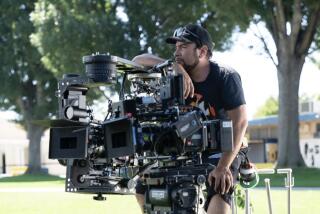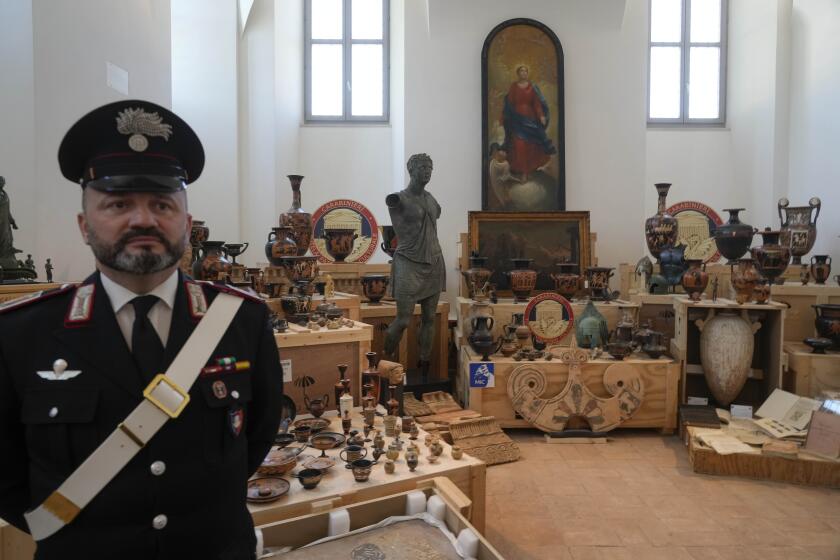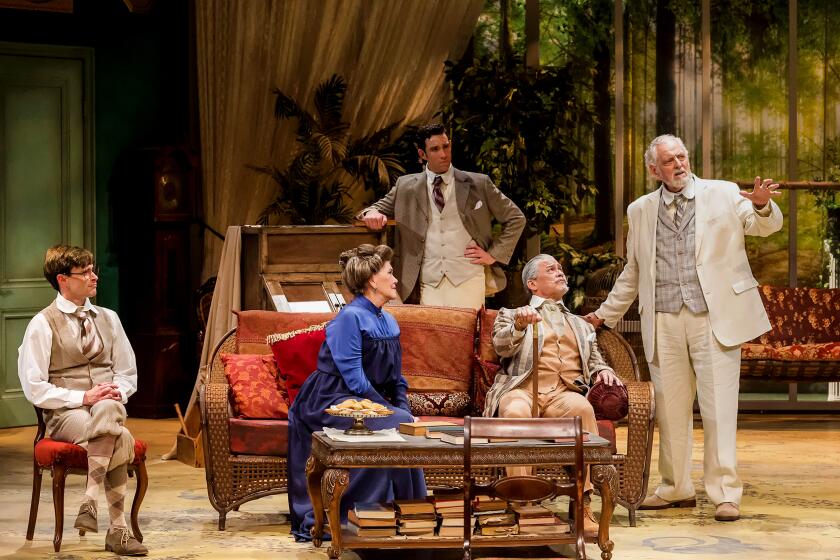PERFORMING ARTS : The Choreographer of Worry : With ‘Waterzooi,’ Maguy Marin wants her audiences to analyze their most basic emotions.
When one of the lead dancers in Maguy Marin’s “Waterzooi” stands doubled over in a belly-aching soliloquy of laughter, we do not laugh with him. Marin doesn’t want us to.
“It’s a fou rire : He’s laughing so hard he doesn’t know what’s going on around him, and you’re outside that. I try to put myself and everybody outside of the emotion, to look at it ,” says the 44-year-old French choreographer. “This is what interests me, not to speak about how I feel, but to speak about what our feelings are. “
“Waterzooi” was created in 1993 and had its U.S. premiere in July, 1994, at the American Dance Festival in Durham, N.C.; it continues its current six-week U.S. tour this week at the Veterans Wadsworth Theater and the Irvine Barclay Theatre, on the heels of a successful two-week run at New York’s Joyce Theater.
The work, named after a Belgian stew, examines some of our most basic emotions. But it wasn’t love or hate that inspired Marin to craft this meditation on the inner life. It was worry .
“I’m very worried all the time. It’s the emotion I feel more than any other,” Marin said on a recent gray Sunday afternoon in Lyon, France’s third-largest city. “It’s very tiring, and very tiring for the people who are living with me,” she acknowledges, sipping an espresso and dragging on her fifth cigarette in an outdoor cafe on the Place des Terreaux. Marin lives outside Lyon with her two children and “the father of my little girl.” She commutes two hours by TGV, France’s high-speed train, to the Parisian suburb of Creteil where her Compagnie Maguy Marin is headquartered.
Marin’s biggest commercial success was a restaging of Cinderella (“Cendrillon,” 1985), commissioned by the Lyon Opera Ballet and notable for its puppet-theater design and elaborate costumes. Americans, however, first took note of her experimental choreography in an earlier work called “May B” (1981), which Compagnie Maguy Marin first presented in this country in 1983. (“May B” and “Cendrillon” were both performed in Los Angeles in 1984.) Inspired by the works of Samuel Beckett, “May B” is closer in spirit to the pared-down aesthetics of “Waterzooi.”
“When I did ‘Cinderella,’ I was very inside myself. The last four or five years, I’ve gotten outside of my feelings. It’s a very different way of working. I think it’s maturity. I wanted ‘Waterzooi’ to be simple, no set, no costumes; to take the dancers and work from there.”
The work got its start when Marin asked composer Denis Mariotte to create some music for her. He came up with a score for instruments such as toy piano, cowbell and harmonica (which the dancers play as part of the performance), and Marin began choreographing and searching for an accompanying text, a new addition to her repertoire. She found Descartes’ “The Passions of the Soul,” which she says “is very French in spirit” and “inspired me to a certain way of being--that coldness, that cerebralness.”
‘Waterzooi’ is a reference for me because I want to go on with this simplicite : Don’t take anything that you don’t need, use what you have, and do something with it,” she says. “With this direction, I feel I can work five years. I have time in front; I didn’t get it yet.”
The critics have been more charitable. In Europe, “Waterzooi” was deemed “un coup de mai^tre,” a master stroke. The New York Times’ Anna Kisselgoff called the 80-minute work “ingenious” and “fiercely original.” In her review during the Joyce Theatre run, Kisselgoff continued: “Marin couches her message in universal terms, which is very different from the confessional tone favored by experimental American choreographers when they provide a take on life.”
In “Waterzooi,” Marin’s take on joy is represented by dancers in cow masks accompanied by a milkmaid in her own happy-face mask; hate is vividly illustrated when a man is strip-searched and humiliated on all fours. A skit about love begins with a slapstick Adam and Eve stripping to their fig leaves and ends as a pair of whispering lovers orbit gymnastically around one another, their voices rising and falling in a kind of agitated music.
The text that sets up each section is often disarmingly banal: “One can be sad for a very specific reason,” one chapter begins. “I am sad because I am sick, poor and ugly,” one dancer says in a monotone. “I am sad because I’m French,” says another. They sound alternately like clinicians reading a definition of an ailment and children reading aloud from a book that chronicles things they haven’t yet felt.
“In a movie you identify yourself with the person on the screen; when somebody is sad you feel the sadness,” Marin says. “Here, something is false.” She wants to untangle some of the mysterious power of emotions by coolly dissecting them onstage.
“What you see depends on who you are. What I see is absurdity,” she says. “I’m rarely so sad or so happy or so angry that I don’t look at myself. We play with emotion. I don’t want to judge that--because I am like that, everybody’s like that. I just want to say: Don’t play too much.”
‘Maguy” Marin was born Margarita to Spanish parents in Toulouse, in the South of France, where she began studying classical ballet at age 8. She later became a soloist with the Strasbourg Opera ballet, before spending three years at the rule-breaking school of Maurice Bejart, one of Europe’s foremost masters of contemporary choreography.
“For 12 years, I was dancing ‘Swan Lake’ and classic ballets that were speaking about a century ago,” Marin recalls. “I wanted to be with people who were speaking about today, creating, trying to move.”
Her toe shoes hit the shelf forever, and Marin began to expand her performance vocabulary to embrace voice, rhythm, theater, gymnastics and martial arts. She founded her own company in 1978. Four years later, after her son was born, she began to concentrate more on making dances than performing them, becoming one of Europe’s most talked about choreographers.
Marin calls her works ballets, but in “Waterzooi” her dancers are dressed in unrevealing khaki street clothes and they don’t leap into the air or sprint across the stage. Movement is often brief or encumbered by words.
“For me, dance is not more important than text of music. It’s as important,” Marin confirms. “I don’t think it’s so important that you see the muscles. I don’t want the dancers to look like dancers. I want them to look like people expressing themselves. I think it’s wrong when you lose the person for the dancer.”
Wearing Doc Martens, a loose brown cardigan over a bright orange skirt and khakis, her red-tinted hair cut in thick bangs and swept up in a pixieish ponytail, Marin doesn’t look much like a dancer herself. She seems smaller than her 5-foot, 3-inch frame and walks in absent-minded, clipped steps marked by a barely discernible turnout.
Her voice is hoarse, yet she talks on and on, trying to explain the ideas that inform her work. Marin’s choreography is often cited for its humor, but in person she is most often thinking too hard to laugh.
One of the more memorable lines from “Waterzooi” is a punishing reference to the victims of genocide: “The truth is people we don’t know, we don’t give a damn about.
“You remember your neighbor’s cat is sick, but you don’t know 100 people have been killed somewhere far away,” Marin says. “I remember watching the news of Rwanda and the war in Bosnia and crying in front of my TV, and I said it’s not possible to continue crying like that--do something. I don’t care about emotion. Emotion is selfish.”
Marin recently spent 18 days on a hunger strike with other French artists to push for resolution of the conflict in Bosnia. She says her work is an attempt to address “everyone’s conscience about our passage sur la terre . . . all those big questions that I leave to everyone to respond to. But you have to act, and politically act. There is a point where art is not enough.”
Fatigued by the hunger strike and preoccupied with family problems, Marin has stayed behind on this, her company’s longest American tour.
“I’m very sorry, I wanted to go so much,” she says. “I have a past with America. Already there is a relation with the audience. The Americans were open from the beginning with ‘May B.’ I had a lot of success in America, which I didn’t have in France after ‘Cinderella,’ which was a very big public success but which the French critics didn’t like.
“I don’t like the whole relationship we have with critics in France,” she says, referring to the fact that French dance companies customarily wine, dine and shuttle critics to performances first-class. “I always trust people more who I don’t know. French critics are in le petit monde , in the little world, and they are bribed, bought. Foreign critics like me or they don’t. They don’t have to pay anything back.”
While Marin waits to see how “Waterzooi” will play beyond the universe of New York City, she is furiously working out a solo for a dancer she kept behind. Asked about her next project, due at the end of 1996, she re-knits her brow and takes a long look into the distance. “I like to go where I don’t know. That’s why I don’t know what I’m going to do next,” she says, and then she smiles. “I don’t know what it’s about. I’m just worrying.”
* ‘ ‘Waterzooi , “ Compagnie Maguy Marin, Veterans Wadsworth Theater, Veterans Administration grounds, Brentwood ; Friday and Saturday, 8 p.m.; $9-$31.50; (310) 825-2101. Also at the Irvine Barclay Theatre, 4242 Campus Road, Irvine, Wednesday, 8 p.m.; $28; (714) 854-4646.
More to Read
The biggest entertainment stories
Get our big stories about Hollywood, film, television, music, arts, culture and more right in your inbox as soon as they publish.
You may occasionally receive promotional content from the Los Angeles Times.






